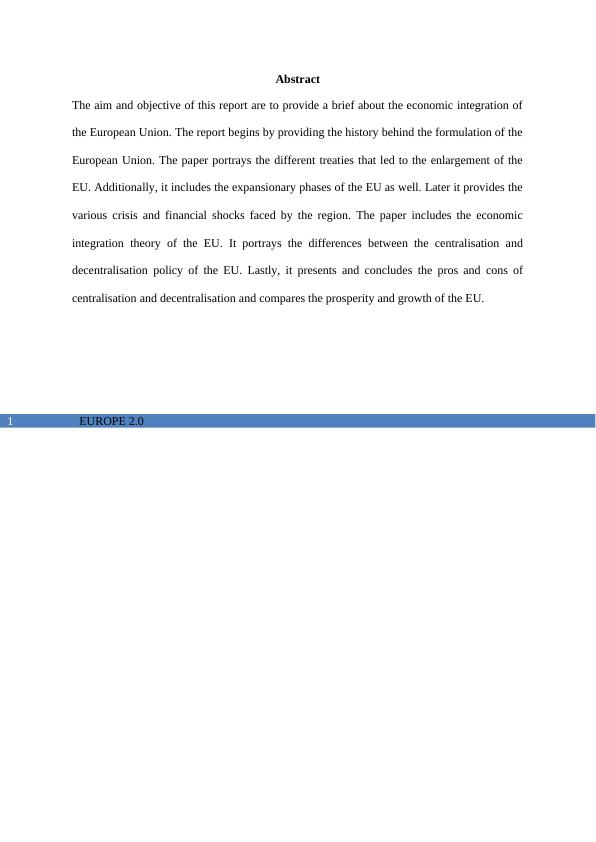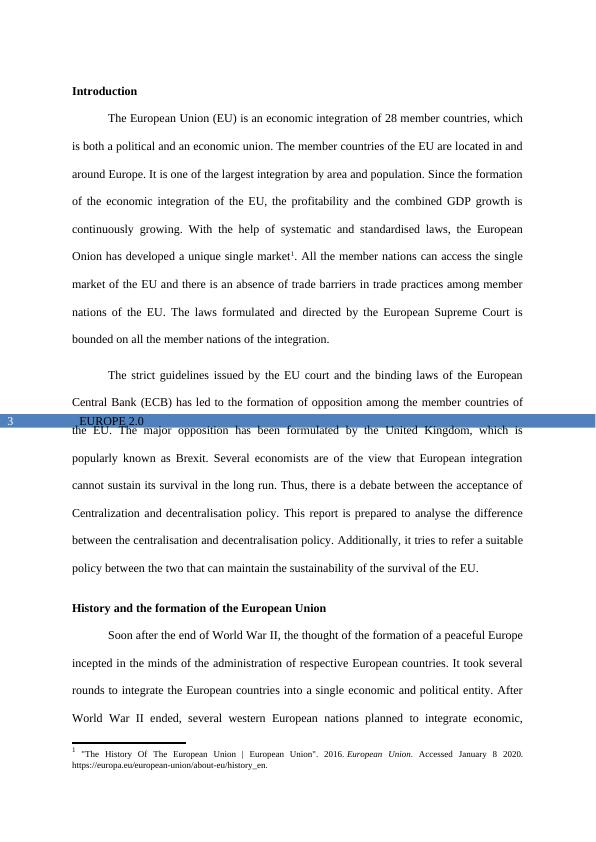Economic Integration of the European Union.
Added on 2022-08-28
16 Pages4052 Words17 Views
Running head: EUROPE 2.0
EUROPE 2.0
Name of the Student
Name of the University
Author Note
Course ID:
EUROPE 2.0
Name of the Student
Name of the University
Author Note
Course ID:

EUROPE 2.01
Abstract
The aim and objective of this report are to provide a brief about the economic integration of
the European Union. The report begins by providing the history behind the formulation of the
European Union. The paper portrays the different treaties that led to the enlargement of the
EU. Additionally, it includes the expansionary phases of the EU as well. Later it provides the
various crisis and financial shocks faced by the region. The paper includes the economic
integration theory of the EU. It portrays the differences between the centralisation and
decentralisation policy of the EU. Lastly, it presents and concludes the pros and cons of
centralisation and decentralisation and compares the prosperity and growth of the EU.
Abstract
The aim and objective of this report are to provide a brief about the economic integration of
the European Union. The report begins by providing the history behind the formulation of the
European Union. The paper portrays the different treaties that led to the enlargement of the
EU. Additionally, it includes the expansionary phases of the EU as well. Later it provides the
various crisis and financial shocks faced by the region. The paper includes the economic
integration theory of the EU. It portrays the differences between the centralisation and
decentralisation policy of the EU. Lastly, it presents and concludes the pros and cons of
centralisation and decentralisation and compares the prosperity and growth of the EU.

EUROPE 2.02
Table of Contents
Introduction................................................................................................................................3
History and the formation of the European Union.....................................................................3
Enlargement procedure of the European Union.....................................................................4
Expansionary phase of the integration and the formal announcement..................................5
The beginning of the End...........................................................................................................6
The global crisis of 2007-2008..............................................................................................7
The 2009 debt crisis and movements against the EU............................................................7
The theory of international integration: Centralization and Decentralization............................9
Centralisation: A curse or blessing......................................................................................10
Aiming at decentralisation...................................................................................................12
Conclusion................................................................................................................................12
References................................................................................................................................14
Table of Contents
Introduction................................................................................................................................3
History and the formation of the European Union.....................................................................3
Enlargement procedure of the European Union.....................................................................4
Expansionary phase of the integration and the formal announcement..................................5
The beginning of the End...........................................................................................................6
The global crisis of 2007-2008..............................................................................................7
The 2009 debt crisis and movements against the EU............................................................7
The theory of international integration: Centralization and Decentralization............................9
Centralisation: A curse or blessing......................................................................................10
Aiming at decentralisation...................................................................................................12
Conclusion................................................................................................................................12
References................................................................................................................................14

EUROPE 2.03
Introduction
The European Union (EU) is an economic integration of 28 member countries, which
is both a political and an economic union. The member countries of the EU are located in and
around Europe. It is one of the largest integration by area and population. Since the formation
of the economic integration of the EU, the profitability and the combined GDP growth is
continuously growing. With the help of systematic and standardised laws, the European
Onion has developed a unique single market1. All the member nations can access the single
market of the EU and there is an absence of trade barriers in trade practices among member
nations of the EU. The laws formulated and directed by the European Supreme Court is
bounded on all the member nations of the integration.
The strict guidelines issued by the EU court and the binding laws of the European
Central Bank (ECB) has led to the formation of opposition among the member countries of
the EU. The major opposition has been formulated by the United Kingdom, which is
popularly known as Brexit. Several economists are of the view that European integration
cannot sustain its survival in the long run. Thus, there is a debate between the acceptance of
Centralization and decentralisation policy. This report is prepared to analyse the difference
between the centralisation and decentralisation policy. Additionally, it tries to refer a suitable
policy between the two that can maintain the sustainability of the survival of the EU.
History and the formation of the European Union
Soon after the end of World War II, the thought of the formation of a peaceful Europe
incepted in the minds of the administration of respective European countries. It took several
rounds to integrate the European countries into a single economic and political entity. After
World War II ended, several western European nations planned to integrate economic,
1 "The History Of The European Union | European Union". 2016. European Union. Accessed January 8 2020.
https://europa.eu/european-union/about-eu/history_en.
Introduction
The European Union (EU) is an economic integration of 28 member countries, which
is both a political and an economic union. The member countries of the EU are located in and
around Europe. It is one of the largest integration by area and population. Since the formation
of the economic integration of the EU, the profitability and the combined GDP growth is
continuously growing. With the help of systematic and standardised laws, the European
Onion has developed a unique single market1. All the member nations can access the single
market of the EU and there is an absence of trade barriers in trade practices among member
nations of the EU. The laws formulated and directed by the European Supreme Court is
bounded on all the member nations of the integration.
The strict guidelines issued by the EU court and the binding laws of the European
Central Bank (ECB) has led to the formation of opposition among the member countries of
the EU. The major opposition has been formulated by the United Kingdom, which is
popularly known as Brexit. Several economists are of the view that European integration
cannot sustain its survival in the long run. Thus, there is a debate between the acceptance of
Centralization and decentralisation policy. This report is prepared to analyse the difference
between the centralisation and decentralisation policy. Additionally, it tries to refer a suitable
policy between the two that can maintain the sustainability of the survival of the EU.
History and the formation of the European Union
Soon after the end of World War II, the thought of the formation of a peaceful Europe
incepted in the minds of the administration of respective European countries. It took several
rounds to integrate the European countries into a single economic and political entity. After
World War II ended, several western European nations planned to integrate economic,
1 "The History Of The European Union | European Union". 2016. European Union. Accessed January 8 2020.
https://europa.eu/european-union/about-eu/history_en.

End of preview
Want to access all the pages? Upload your documents or become a member.
Related Documents
EU Enlargement and Its Benefits to Firms: History, Waves of Integration, and Recommendationslg...
|8
|2152
|213
Impact of European Integration on National Parliamentslg...
|7
|2181
|53
Implications of Eastward Enlargementlg...
|14
|4153
|66
Business issues in the contemporary worldlg...
|9
|2591
|1
Business issues in the contemporary worldlg...
|9
|2663
|47
Global Impact of Brexit | Assignmentlg...
|13
|3289
|222
